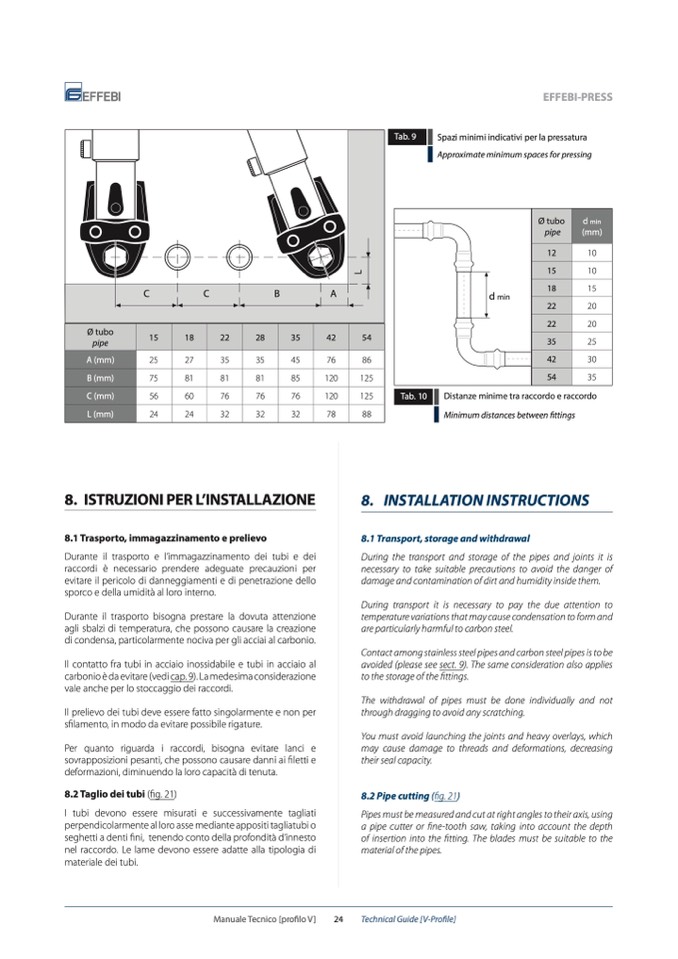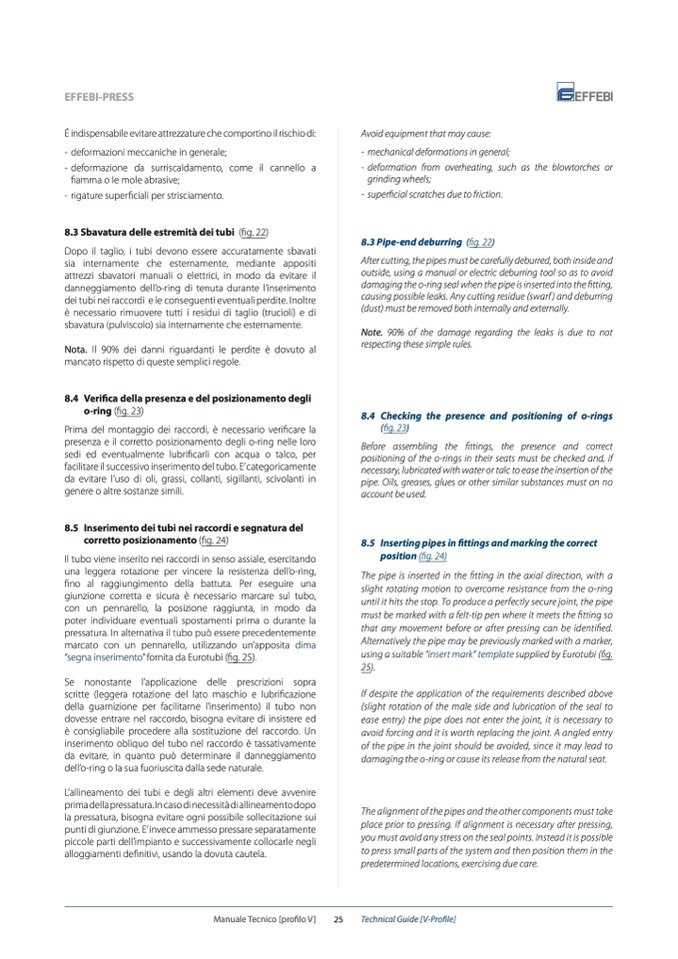


É indispensabile evitare attrezzature che comportino il rischio di:
- deformazioni meccaniche in generale;
- deformazione da surriscaldamento, come il cannello a
fiamma o le mole abrasive;
- rigature superficiali per strisciamento.
8.3 Sbavatura delle estremità dei tubi (
fig. 22)
Dopo il taglio, i tubi devono essere accuratamente sbavati
sia internamente che esternamente, mediante appositi
attrezzi sbavatori manuali o elettrici, in modo da evitare il
danneggiamento dell’o-ring di tenuta durante l’inserimento
dei tubi nei raccordi e le conseguenti eventuali perdite. Inoltre
è necessario rimuovere tutti i residui di taglio (trucioli) e di
sbavatura (pulviscolo) sia internamente che esternamente.
Nota. Il 90% dei danni riguardanti le perdite è dovuto al
mancato rispetto di queste semplici regole.
8.4 Verifica della presenza e del posizionamento degli
o-ring (fig. 23)
Prima del montaggio dei raccordi, è necessario verificare la
presenza e il corretto posizionamento degli o-ring nelle loro
sedi ed eventualmente lubrificarli con acqua o talco, per
facilitare il successivo inserimento del tubo. E’categoricamente
da evitare l’uso di oli, grassi, collanti, sigillanti, scivolanti in
genere o altre sostanze simili.
8.5 Inserimento dei tubi nei raccordi e segnatura del
corretto posizionamento (fig. 24)
Il tubo viene inserito nei raccordi in senso assiale, esercitando
una leggera rotazione per vincere la resistenza dell’o-ring,
fino al raggiungimento della battuta. Per eseguire una
giunzione corretta e sicura è necessario marcare sul tubo,
con un pennarello, la posizione raggiunta, in modo da
poter individuare eventuali spostamenti prima o durante la
pressatura. In alternativa il tubo può essere precedentemente
marcato con un pennarello, utilizzando un’apposita dima
“segna inserimento” fornita da Eurotubi (
fig. 25).
Se nonostante l’applicazione delle prescrizioni sopra
scritte (leggera rotazione del lato maschio e lubrificazione
della guarnizione per facilitarne l’inserimento) il tubo non
dovesse entrare nel raccordo, bisogna evitare di insistere ed
è consigliabile procedere alla sostituzione del raccordo. Un
inserimento obliquo del tubo nel raccordo è tassativamente
da evitare, in quanto può determinare il danneggiamento
dell’o-ring o la sua fuoriuscita dalla sede naturale.
L’allineamento dei tubi e degli altri elementi deve avvenire
prima della pressatura. In caso di necessità di allineamento dopo
la pressatura, bisogna evitare ogni possibile sollecitazione sui
punti di giunzione. E’ invece ammesso pressare separatamente
piccole parti dell’impianto e successivamente collocarle negli
alloggiamenti definitivi, usando la dovuta cautela.
Avoid equipment that may cause:
- mechanical deformations in general;
- deformation from overheating, such as the blowtorches or
grinding wheels;
- superficial scratches due to friction.
8.3 Pipe-end deburring (fig. 22)
After cutting, the pipes must be carefully deburred, both inside and
outside, using a manual or electric deburring tool so as to avoid
damaging the o-ring seal when the pipe is inserted into the fitting,
causing possible leaks. Any cutting residue (swarf ) and deburring
(dust) must be removed both internally and externally.
Note. 90% of the damage regarding the leaks is due to not
respecting these simple rules.
8.4 Checking the presence and positioning of o-rings
(fig. 23)
Before assembling the fittings, the presence and correct
positioning of the o-rings in their seats must be checked and, if
necessary, lubricated with water or talc to ease the insertion of the
pipe. Oils, greases, glues or other similar substances must on no
account be used.
8.5 Inserting pipes in fittings and marking the correct
position (fig. 24)
The pipe is inserted in the fitting in the axial direction, with a
slight rotating motion to overcome resistance from the o-ring
until it hits the stop. To produce a perfectly secure joint, the pipe
must be marked with a felt-tip pen where it meets the fitting so
that any movement before or after pressing can be identified.
Alternatively the pipe may be previously marked with a marker,
using a suitable “insert mark” template supplied by Eurotubi (fig.
25).
If despite the application of the requirements described above
(slight rotation of the male side and lubrication of the seal to
ease entry) the pipe does not enter the joint, it is necessary to
avoid forcing and it is worth replacing the joint. A angled entry
of the pipe in the joint should be avoided, since it may lead to
damaging the o-ring or cause its release from the natural seat.
The alignment of the pipes and the other components must take
place prior to pressing. If alignment is necessary after pressing,
you must avoid any stress on the seal points. Instead it is possible
to press small parts of the system and then position them in the
predetermined locations, exercising due care.
Manuale Tecnico [profilo V]
25
Technical Guide [V-Profile]



